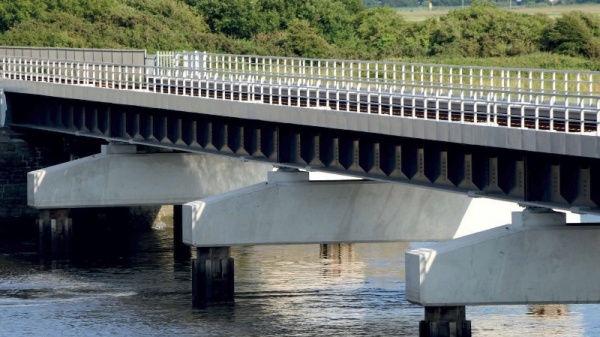Difference between revisions of "Loughor Viaduct Replacement, South Wales"
(Created page with "==Structural Steel Design Awards 2014 - Commendation== Forming part of the Gowerton re-doubling scheme, the new replacement steel composite des...") |
|||
| Line 43: | Line 43: | ||
[[Category:Case studies – Bridges]] | [[Category:Case studies – Bridges]] | ||
| + | [[Category:SSDA]] | ||
Revision as of 12:22, 12 March 2019
Structural Steel Design Awards 2014 - Commendation
Forming part of the Gowerton re-doubling scheme, the new replacement steel composite designed Loughor Viaduct has reinstated a double track rail service across the South Wales estuary, improving travel times between Swansea and Llanelli and boosting the local economy.
Originally constructed in 1852, the viaduct was initially a wooden structure and a fine example of Isambard Kingdom Brunel’s once numerous timber viaducts.
Recent detailed site investigations had determined that the old viaduct had reached the end of its life.
In order to improve rail services and restore the line to a double track configuration Network Rail, working with Carillion Rail, opted to replace the entire structure as part of a £48M scheme.
The new bridge has a total of seven spans, five of which are 36m long, and was constructed in structural steelwork.
A primary consideration was how the new viaduct could be constructed within the limited 249-hour blockade provided by Network Rail.
Steelwork contractor Mabey Bridge completed the three-month fabrication of the structural steelwork and walkways at its facility in Chepstow, while temporary works and new bridge piers were being constructed either side of the existing viaduct in the high flow tidal estuary.
Mabey Bridge was also contracted to oversee site assembly, including the supply of temporary pier cross beams to support the launch of the new structure. These beams were installed atop six temporary piers that had been installed on the north side of the existing viaduct.
Steelwork was delivered to site in 24m long lengths and assembled in a laydown area on the west side of the estuary.
Once the first section was assembled, it was launched using strand jacks over the river onto temporary piers. Mabey Bridge then assembled the next section of the deck, bolted it onto the previous section and launched the entire structure further over the river.
This process was repeated a further three times to position the entire new viaduct adjacent to the existing structure. The steelwork was then jacked down onto its permanent bearings. The deck was concreted, waterproofed, ballasted and tracks laid.
The 249-hour rail possession was then initiated and the old structure demolished. Once it had been dismantled and new abutments constructed the new viaduct was slid sideways on its bearings to its permanent location using hydraulic rams.
After the viaduct opened one of Carillion Rail’s final tasks on site was to construct a heritage monument to reflect the old structure. Positioned on the west bank of the estuary, the monument consists of two of the original spans mounted on three of the original trestles.
| Structural Engineer | Tony Gee and Partners LLP |
| Steelwork Contractor | Mabey Bridge Ltd |
| Main Contractor | Carillion Rail |
| Client | Network Rail |
Judges' comment
Replacement of the existing single-track, Brunel inspired viaduct imposed major demands on the team. The practical design of the new twin-track crossing assisted the prefabrication on site of the steel girder deck, which was then launched and slid into place within a 249-hour blockade.
An heroic and successful achievement.




